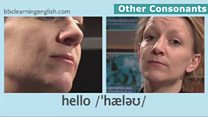Unit 25: Towards Advanced
Grammar, news, vocabulary and pronunciation
Select a unit
- 1 Towards advanced
- 2 Towards advanced
- 3 Towards advanced
- 4 Towards advanced
- 5 Towards advanced
- 6 Towards advanced
- 7 Towards advanced
- 8 Towards advanced
- 9 Towards Advanced
- 10 Towards Advanced
- 11 Towards Advanced
- 12 Towards Advanced
- 13 Towards Advanced
- 14 Towards Advanced
- 15 Towards Advanced
- 16 Towards Advanced
- 17 Towards Advanced
- 18 Towards Advanced
- 19 Towards Advanced
- 20 Towards Advanced
- 21 Towards Advanced
- 22 Towards Advanced
- 23 Towards Advanced
- 24 Towards Advanced
- 25 Towards Advanced
- 26 Towards Advanced
- 27 Towards Advanced
- 28 Towards Advanced
- 29 Towards Advanced
- 30 Towards Advanced
Session 5
Tim's Pronunciation Workshop: assimilation of /d/ and /b/
What happens when one word ends in a /d/ sound and the next one begins in /b/?
Activity 1
Tim's Pronunciation Workshop: /d/ - /b/ assimilation
He's been a good boy
Tim's back in his pronunciation workshop. This time he's finding out what happens when one word ends in /d/ and the next begins in /b/ - and talking speed boats with some Londoners...
To do
Take a look at the video, then try the activity to do some practice.
Watch the video and complete the activity

Tim
Hi. I'm Tim and this is my Pronunciation workshop. Here I'm going to show you how English is really spoken. Come on, let's go inside. Now, do you know the word speeb? No, of course not because it’s not a real word. Or is it? Listen to some people in London talking about this.
Voxpops
It’s a speed boat.
Speed boat.
Speed boat.
Speed boat.
Speed boat.
Tim
Now, the word speed ends in the sound /d/, doesn’t it? Well not always. Watch and listen again, what sound can you actually hear?
Voxpops
It’s a spee? boat.
Spee? boat.
Spee? boat.
Spee? boat.
Spee? boat.
Tim
In everyday speech, when we’re speaking fluently, if one word ends in a vowel sound followed by a /d/ and the next begins in a /b/, then the /d/ changes to a /b/ and then merges with the /b/ from the following word. So ‘speed boat’, becomes ‘speebboat’. Watch again, this time in slow motion. Look at the mouth shape. Can you see /d/ or is it just /b/?
Voxpops
Speeb boat.
Speeb boat.
Speeb boat.
Speeb boat.
Speeb boat.
Tim
This is another case of assimilation. Here are some more examples.
Examples
My son is a really good boy.
I’m sorry if I was rude before.
My car had to be towed back to the garage.
You should buy him a present.
Tim
So, you’ve heard the examples, and now it’s your turn. You know the drill. Listen and repeat.
Examples
My son is a really good boy.
I’m sorry if I was rude before.
My car had to be towed back to the garage.
You should buy him a present.
Tim
Well done. And remember, if you want to learn more about pronunciation, then please visit our website, bbclearningenglish.com. And that is about it from the pronunciation workshop for this week. I’ll see you soon. Bye bye! Aah – you know, one day I’m going to get one of these. Not a toy, obviously, but the real thing. My dad promised. He said if I was a good boy he’d buy me a boat. That was quite a long time ago actually. I think I was five years old – and I have been a good boy. Maybe he’s just forgotten. I’m never going to get my speed boat, am I?
To do
So that's a look at assimilation of /d/ followed by /b/ in natural spoken English. Now try this activity to get some more practice.
The assimilation of /d/ and /b/ game
6 Questions
Which phrases are examples of assimilation of /d/ and /b/? You decide...
Help
Activity
Which phrases are examples of assimilation of /d/ and /b/? You decide...
Hint
When a word ends in a /d/ sound and the next word begins with a /b/ sound, the /d/ changes to a /b/, which then merges with the /b/ from the following word.Question 1 of 6

Help
Activity
Which phrases are examples of assimilation of /d/ and /b/? You decide...
Hint
When a word ends in a /d/ sound and the next word begins with a /b/ sound, the /d/ changes to a /b/, which then merges with the /b/ from the following word.Question 2 of 6

Help
Activity
Which phrases are examples of assimilation of /d/ and /b/? You decide...
Hint
When a word ends in a /d/ sound and the next word begins with a /b/ sound, the /d/ changes to a /b/, which then merges with the /b/ from the following word.Question 3 of 6

Help
Activity
Which phrases are examples of assimilation of /d/ and /b/? You decide...
Hint
When a word ends in a /d/ sound and the next word begins with a /b/ sound, the /d/ changes to a /b/, which then merges with the /b/ from the following word.Question 4 of 6

Help
Activity
Which phrases are examples of assimilation of /d/ and /b/? You decide...
Hint
When a word ends in a /d/ sound and the next word begins with a /b/ sound, the /d/ changes to a /b/, which then merges with the /b/ from the following word.Question 5 of 6

Help
Activity
Which phrases are examples of assimilation of /d/ and /b/? You decide...
Hint
When a word ends in a /d/ sound and the next word begins with a /b/ sound, the /d/ changes to a /b/, which then merges with the /b/ from the following word.Question 6 of 6

Excellent! Great job! Bad luck! You scored:
End of Unit 25
We hope that was useful. In Unit 26, Dan shows you Inversion part 2 in Masterclass. In News Review and LingoHack you can find out which words are making the headlines - and Tim will be back with the pronunciation workshop as usual. See you there!
Session Vocabulary
Assimilation of /d/ to /b/
When one word ends in /d/ and the next begins in /b/, the /d/ becomes /b/ and then merges with the /b/ in the following word.
- Good boy!
- You should buy me a present!


